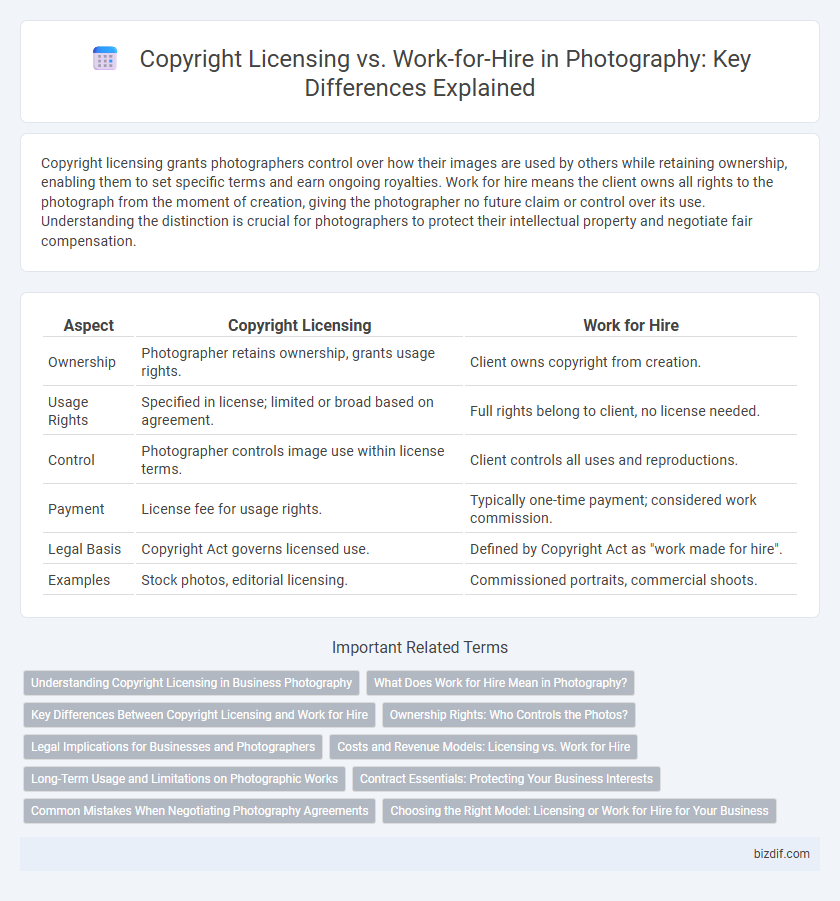Copyright licensing grants photographers control over how their images are used by others while retaining ownership, enabling them to set specific terms and earn ongoing royalties. Work for hire means the client owns all rights to the photograph from the moment of creation, giving the photographer no future claim or control over its use. Understanding the distinction is crucial for photographers to protect their intellectual property and negotiate fair compensation.
Table of Comparison
| Aspect | Copyright Licensing | Work for Hire |
|---|---|---|
| Ownership | Photographer retains ownership, grants usage rights. | Client owns copyright from creation. |
| Usage Rights | Specified in license; limited or broad based on agreement. | Full rights belong to client, no license needed. |
| Control | Photographer controls image use within license terms. | Client controls all uses and reproductions. |
| Payment | License fee for usage rights. | Typically one-time payment; considered work commission. |
| Legal Basis | Copyright Act governs licensed use. | Defined by Copyright Act as "work made for hire". |
| Examples | Stock photos, editorial licensing. | Commissioned portraits, commercial shoots. |
Understanding Copyright Licensing in Business Photography
Copyright licensing in business photography grants clients specific usage rights while the photographer retains ownership of the images, allowing control over reproduction, distribution, and modification. Licensing agreements detail the scope, duration, and exclusivity of image use, ensuring clear legal boundaries and protecting the photographer's intellectual property. Understanding these terms is crucial for businesses to avoid legal disputes and secure appropriate rights for marketing, advertising, and digital platforms.
What Does Work for Hire Mean in Photography?
Work for hire in photography means the photographer creates images as an employee or under a contract that explicitly states the work belongs to the client. Unlike copyright licensing, where photographers retain ownership and grant usage rights, work for hire transfers all copyright ownership to the employer or client upon creation. This distinction affects how images can be used, shared, and monetized, making it crucial for photographers to understand contract terms before accepting assignments.
Key Differences Between Copyright Licensing and Work for Hire
Copyright licensing grants photographers permission to use, share, or sell their images while retaining ownership, allowing them to control how their work is utilized. Work for hire agreements transfer copyright ownership from the photographer to the client, meaning the client holds all rights to the images created under the contract. Understanding these distinctions is crucial for photographers to protect their intellectual property and negotiate terms that align with their business goals.
Ownership Rights: Who Controls the Photos?
In copyright licensing, photographers retain ownership rights and grant clients limited permissions to use the images, maintaining control over reproduction and distribution. Work for hire agreements transfer ownership directly to the client upon creation, giving them full control over the photos without needing further consent from the photographer. Understanding these distinctions is crucial for photographers to protect their intellectual property and for clients to secure desired usage rights.
Legal Implications for Businesses and Photographers
Copyright licensing grants photographers control over how their images are used, allowing businesses to obtain specific usage rights while the photographer retains ownership, ensuring ongoing royalties or usage fees. In contrast, work for hire agreements transfer full copyright ownership to the business upon creation, giving companies exclusive rights to reproduce, distribute, and modify the images without further permission or compensation to the photographer. Businesses must carefully evaluate these legal structures to protect intellectual property rights, minimize liability risks, and establish clear terms in contracts to avoid disputes over usage and ownership.
Costs and Revenue Models: Licensing vs. Work for Hire
Copyright licensing allows photographers to retain ownership of their images while generating ongoing revenue through usage fees, often based on exclusivity, duration, and media type. In contrast, work for hire agreements transfer all rights to the client upfront, typically involving a one-time flat fee without future royalties, limiting long-term income potential. Licensing models offer scalable earnings aligned with image demand, whereas work for hire provides immediate, fixed compensation with no residual benefits.
Long-Term Usage and Limitations on Photographic Works
Copyright licensing grants photographers control over how their images are used, allowing for long-term usage under agreed terms, while retaining ownership rights. Work for hire agreements transfer ownership of photographic works to the client, eliminating the photographer's rights and limiting their ability to reuse or license the images independently. Understanding these distinctions is essential for managing intellectual property, usage rights, and potential revenue streams in professional photography.
Contract Essentials: Protecting Your Business Interests
Understanding Copyright Licensing and Work for Hire agreements is crucial for photographers to safeguard their creative assets and define usage rights clearly. Contracts must explicitly outline ownership, usage permissions, compensation terms, and duration of rights to prevent disputes and unauthorized exploitation. Prioritizing clear, legally binding contract essentials ensures photographers maintain control over their intellectual property while securing business interests.
Common Mistakes When Negotiating Photography Agreements
Misunderstanding the difference between copyright licensing and work for hire often leads to disputes over image ownership and usage rights in photography agreements. Photographers frequently err by granting overly broad licenses without clear boundaries, risking unauthorized exploitation of their work. Clients, on the other hand, sometimes assume a work-for-hire agreement transfers all copyrights automatically, which can cause legal complications if not explicitly documented.
Choosing the Right Model: Licensing or Work for Hire for Your Business
Selecting the appropriate model between copyright licensing and work for hire is crucial for photographers managing intellectual property and usage rights. Copyright licensing allows photographers to retain ownership while granting specific usage permissions, maximizing control and potential royalties. Work for hire agreements transfer all rights to the client, often simplifying ownership but limiting ongoing revenue, making the choice dependent on long-term business goals and project scope.
Copyright Licensing vs Work for Hire Infographic

 bizdif.com
bizdif.com